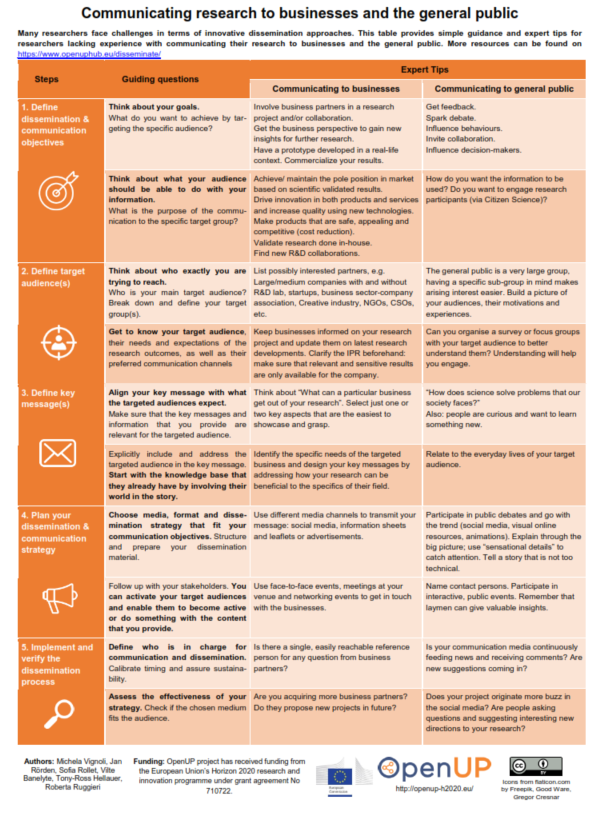Disseminating to general public
 |
All you need to know to promote your research to businesses - The "why", the "what" & the "how" in disseminating to businesses. |
1. Requirements and expectations: why is the general public interested in science information?
The general public is a very large group, and without having a specific sub-group in mind it is difficult to pinpoint their interest. In many cases, the general public is not actively looking for specific information from research. However, citizens are generally interested in understanding how science is trying to solve current or upcoming challenges.
The general public is interested in a lot of science contents; it does not matter if it is cancer research, chemistry, biology etc. What is important is that they can get something away from the story, and that they gained some knowledge in this process. They are interested in science e.g. due to personal reasons, a pure interest to learn new knowledge, or because they have a particular problem that they want to solve.
Some stakeholders from the general public (e.g. patients) have a major interest to talk to the experts and to get actively involved in research - either due to their personal situation or their enthusiasm or passion for science. Be aware that if you highlight researchers in your communication strategy, individual citizens or patient organisations might contact them directly.
The general public is interested in a lot of science contents; it does not matter if it is cancer research, chemistry, biology etc. What is important is that they can get something away from the story, and that they gained some knowledge in this process. They are interested in science e.g. due to personal reasons, a pure interest to learn new knowledge, or because they have a particular problem that they want to solve.
Some stakeholders from the general public (e.g. patients) have a major interest to talk to the experts and to get actively involved in research - either due to their personal situation or their enthusiasm or passion for science. Be aware that if you highlight researchers in your communication strategy, individual citizens or patient organisations might contact them directly.
2. What information do businesses require from research?
Everything that is being researched will find interest somewhere at the general public. However, it should be disseminated in an appropriate format. Communicating to the general public sums down to reasoning with the audiences (e.g. how can I convey my message to a butcher?). It is important to transport clear and exciting information snippets and to tell a story.
The general public is interested in information that has a direct connection to whatever is on their mind at the moment. There are moments in which citizens are interested in something specific, e.g. if they need to decide on a treatment or to deal with pollution in their garden. But when they are looking for input and evidence it is really hard for them to find. There is a disconnection between research information providers and receivers: there are a lot of flashpoints and need to understanding research information. However, when citizens are in need for this information, it is often not provided on the channels that they are looking to.
This is very hard to tackle as it is not always predictable when people need the information. A common mistake in science communication is to present research in a nice and easy to understand way and to expect that this suffices to make it interesting for people. However, research needs to find innovative ways for its results to be easily findable once the need by the targeted audiences arises. A possibility is to observe and be very active in public debate (i.e. daily environment, social media). If the research community becomes more open to discuss and actively participate in public debates, it would be easier for the general public to find research information.
Some citizens are also interested in finding expert contact persons. For instance, in the health research area individual citizens might contact researchers who are declared as contact persons for specific research projects or areas.
This can be challenging if the project is in a really early stage; especially where concepts are still being developed. In these cases, it is recommendable to tune down the information to be shared. This is particularly relevant to the health research area, where people are desperate to find results and cures. It is important to not give them too much (or false) hopes.
The general public is interested in information that has a direct connection to whatever is on their mind at the moment. There are moments in which citizens are interested in something specific, e.g. if they need to decide on a treatment or to deal with pollution in their garden. But when they are looking for input and evidence it is really hard for them to find. There is a disconnection between research information providers and receivers: there are a lot of flashpoints and need to understanding research information. However, when citizens are in need for this information, it is often not provided on the channels that they are looking to.
This is very hard to tackle as it is not always predictable when people need the information. A common mistake in science communication is to present research in a nice and easy to understand way and to expect that this suffices to make it interesting for people. However, research needs to find innovative ways for its results to be easily findable once the need by the targeted audiences arises. A possibility is to observe and be very active in public debate (i.e. daily environment, social media). If the research community becomes more open to discuss and actively participate in public debates, it would be easier for the general public to find research information.
Some citizens are also interested in finding expert contact persons. For instance, in the health research area individual citizens might contact researchers who are declared as contact persons for specific research projects or areas.
This can be challenging if the project is in a really early stage; especially where concepts are still being developed. In these cases, it is recommendable to tune down the information to be shared. This is particularly relevant to the health research area, where people are desperate to find results and cures. It is important to not give them too much (or false) hopes.
3. Form/Format of communication to general public
Like for the business target audience, there is communication format fitting all general public target audiences. Flexibility is the key, and the format to be chosen depends on your dissemination objectives.
When communicating research outcomes to the general public, it is important to explain them through the big picture. There are various communication registries. The communication format should not be too technical and it should tell a story. By following a storyline, complex topics can be more easily communicated to citizens. Attach the topic to a sensational detail to draw interest and to engage your audience.
Explain what research does to improve their life and relate it to their everyday life. Even in areas where stakeholders (e.g. patients or patient organisations) might be actively looking for information, you still need to communicate through the big picture.
There are various possibilities: organising a big communication campaign; targeting a very specific target group (e.g. patients); or provide pure information that people are waiting for. A more conventional way is to issue a press release going to local or international media. However, using social media such as Facebook, LinkedIn, or Twitter helps gaining some visibility. It is recommendable to go with the social media trend and use, next to text, visual online resources (e.g. videos, animations). The latter are more appealing and easy to share.
Also, it is recommendable to not only provide information, but to stimulate a dialogue with your general public target audience. This needs creativity and flexibility. Very important are also events targeting general public audiences. An example are EU researchers nights targeting school or high-school children as well as adults.
When communicating research outcomes to the general public, it is important to explain them through the big picture. There are various communication registries. The communication format should not be too technical and it should tell a story. By following a storyline, complex topics can be more easily communicated to citizens. Attach the topic to a sensational detail to draw interest and to engage your audience.
Explain what research does to improve their life and relate it to their everyday life. Even in areas where stakeholders (e.g. patients or patient organisations) might be actively looking for information, you still need to communicate through the big picture.
There are various possibilities: organising a big communication campaign; targeting a very specific target group (e.g. patients); or provide pure information that people are waiting for. A more conventional way is to issue a press release going to local or international media. However, using social media such as Facebook, LinkedIn, or Twitter helps gaining some visibility. It is recommendable to go with the social media trend and use, next to text, visual online resources (e.g. videos, animations). The latter are more appealing and easy to share.
Also, it is recommendable to not only provide information, but to stimulate a dialogue with your general public target audience. This needs creativity and flexibility. Very important are also events targeting general public audiences. An example are EU researchers nights targeting school or high-school children as well as adults.





